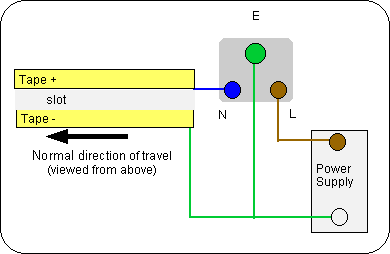Good
Ways of Blowing up Switching Controllers
(and How to Avoid them)
new January 2004 with minor updates 2014
1) Shorting Out The Tapes
Another how it works question,,,, what happens if there's a short circuit across the motor (e.g. the chassis shorts out the tapes)?
Answer - The transistor tries to provide more current to compensate. A short circuit could well force at least 100amps through the transistor. Some of the transistors used in switching controllers can take a lot more current than this.
What does this mean?
Answer - If you get a good solid short with a switching controller you might get away without problems, but do you want to take the risk
How do you get round this problem?
Answer - put some sellotape or insulating varnish on the bottom of you cars so they don't short out the tapes. Always unplug your controller (or at the very least don't press it) when somebody is putting the tapes down - if they are using something solid and metal it will produce a very good short circuit. If you are repairing the tapes please take a care to warn the driver! (Quite apart from any controller damage, it'll stop them driving their cars into you!)
2) Other Good Ways of Producing Short Circuits
Switching controllers usually have the power transistors insulated and mounted in a box out of harms way. Resist the temptation to go fiddling around inside the box and risk blowing something up!
3) Some Like It Hot!! (but your transistor doesn't)
Switching type controllers produce much less heat, and should be virtually immune to the overheating problems that can cause linear controllers to cry enough. However, switching controllers do produce some waste heat, very little in some designs, in others there is enough heat to get rid of that the designers have included a heat sink and cooling fan. If the transistors in a switching type circuit do start getting hot it is most likely to indicate a controller fault.
The only circumstances where they might get hot in "normal" use is when the track power has dropped drastically so there isn't enough voltage to turn the switching transistors on properly. This is very unlikely in normal use and would only occur once there was so little power that the cars are going really slow!
4) The Dirt Bits!
This only occurs in controllers which have a wiper running on a contact board. The RMD controller is an example that doesn't have a wiper board so will be immune to this problem
Probably the most frequent cause of transistor failure in linear controllers is tracking between the brake terminal and the top of the resistor contacts. This is caused by a conductive deposit on the contact board where the wiper runs - usually remains of the contact brush etc. What impact this will have on a switching controller depends on the circuit details.
5) A Bridge Too Far
Bridging problems only occur in controllers which have a wiper running on a contact board, or other separate contacts. The RMD controller is an example that doesn't have a wiper board so will be immune to this problem.
It is likely to be important that any electrical contacts make and break in the correct sequence, but right now I don't have sufficient experience of maintaining this type of controller to offer nay advice.
6) Track Wired Incorrectly
Transistors only pass current in one direction - if the track is wired to BSCRA standards (with the controller between the + side of the power supply and the track) your controller will work fine. If the track is wired incorrectly (with the controller between the negative side of the power supply and the track) read the manufacturers instructions before plugging it in. It's likely it won't work and may well be damaged. Incidentally, this has got nothing to do with wiring the car up to go forwards or backwards.
 Correct
Track Wiring (updated to 2003 BSCRA Standards)
Correct
Track Wiring (updated to 2003 BSCRA Standards)